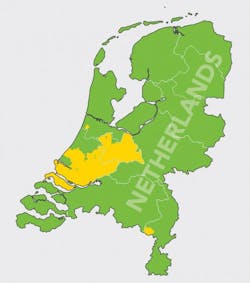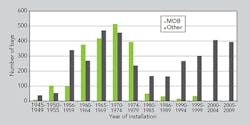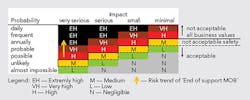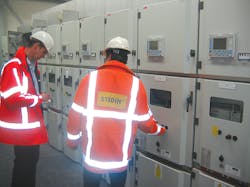An Increased Focus on Breaker Reliability
The electricity grid in the Netherlands was mainly constructed from 1945 to 1980, so these aging assets are a major concern for electrical network operators. Of particular concern is the termination of support from the original equipment manufacturers (OEMs), or their successors, which threatens proper maintenance and the availability of spare parts.
Stedin Netbeheer B.V. is a regional network operator responsible for the transmission and distribution of electricity in Randstad, a large urban area in western Netherlands that includes the cities of The Hague, Rotterdam and Utrecht. More than 2 million customers are connected to the Stedin distribution network. The subtransmission grid operates at 50 kV and 25 kV, and the medium-voltage (MV) distribution network has voltages of 13 kV and 10 kV.
Stedin strives to control its key business risks — reliability of supply and safety — which are closely related to the public interest and the reputation of the network operator. Therefore, the failure of high-/medium-voltage (HV/MV) substations is a risk that can adversely impact the reliability of supply. Aging assets no longer supported by the OEM, now or in the near future, are part of this risk. This was the situation Stedin faced when the OEM for almost all of its minimum oil breakers (MOBs) gave notice in December 2010 that it would terminate support in 2014.
Controlling Risks
Large quantities of MOBs were installed on the Dutch network, including medium-/low-voltage (MV/LV) distribution cabinets and Stedin’s HV/MV substations with operating voltages of 10 kV to 25 kV. Many MOBs are still in operation, with about 2200 bays in HV/MV substations (around 35% of all bays in the HV/MV substations) and approximately 3200 units in distribution cabinets.
The majority of this type of switchgear in the Stedin grid has an oil-filled main bus bar system and oil-filled breaker compartments, usually containing oil-filled breaker tubes (including arc chambers) separated by phase barriers. The systems have separated tanks that are not hermetically sealed. Various components, including the breaker tubes, are made of thin layers of resin-impregnated paper. The operating mechanism is often powered pneumatically or hydraulically.
The termination of support by the OEM eventually may lead to an increase in the failure frequency, extended refurbishment times or irreparable loss of function, as the knowledge and experience required for maintenance, inspection and repair are no longer available. Specific spare parts and the possibility of modifications may be affected now that OEM support has ended. Based on experience, a specific risk attributable to a MOB is the possibility the cubicle may burst, as a result of a short circuit, causing a flow of hot oil or gas, possibly creating a fire. This is a potential safety hazard for employees and can result in a loss of electricity supply to customers. In practice, these failures typically occur during or shortly after operation of the switchgear.
Failure Modes
Research has been conducted into the failure mechanisms of MOBs, but neither Stedin nor the OEM have identified age as a predominant fault cause. Various failure phenomena are known whose probability is affected by multiple variables, such as in-service failures, maintenance history, circuit breaker operations and environmental influences. The most likely major failure modes are no movement or uncontrolled movement of the contacts or insulation faults.
These failures require unplanned corrective actions to ensure or recover the supply of power and to restore the functionality of the circuit breaker. Additionally, many minor failures include small leaks or problems in remote control that also result in the need for corrective maintenance. The most likely causes of failure were determined by the OEM based on consensus within a team of experts. Using a classification range from “occurs monthly” to “never heard of,” the majority of MOB failures are almost identical for each type of circuit breaker (for example, related to contact pressure, oil condition, mechanical adjustments and wear of breaker contacts). Furthermore, several type-specific characteristics exist related to design or material specifications.
Failure Effects and Risk Classification
Stedin assesses events such as a fire and loss of a substation based on the impact to its five business values:
• Safety
• Quality of supply
• Financial performance
• Reputation
• Laws and regulations.
An event is evaluated on a risk matrix, based on the frequency of the event and the effects on the business values. Details of the risk matrices are different in the electrical industry, but the common use of risk classification permits a common understanding in the sector, in this case, between the OEM and Stedin. According to Stedin’s risk matrix, the business risk would become unacceptably high when support from the OEM was terminated if Stedin were unable to establish a means of regular maintenance and support.
For example, the impact of the loss of MOB switchgear in a typical HV/MV substation supplying some 20,000 customers has a huge effect on the business value quality of supply. If the outage lasts 12 hours before supplies are restored, customer minutes lost (CML) will be over 14 million and system average interruption duration index (SAIDI) will increase in the current year by approximately 28%. This impact would be classified as very serious. The probability of such an event would increase over the years from possible (that is, once in decades, based on past experience) while OEM support was available, to annually some 10 years after the end of support by the OEM. The risk then rises from high to very high to extremely high.
The effect of an interruption goes far beyond energy not supplied or compensation for damages. Because of the 24-hour economy and dependence on IT systems, the cost of an outage is significantly higher today than it was 10 to 20 years ago. Nowadays, the impact on the reputation of the network operator is also much more damaging.
Two-Track Approach
Given the unacceptably high risk when support by the OEM is terminated, the network operator examined various options to ensure the future safety and reliability of HV/MV substations and distribution cabinets:
• Operation until irretrievable loss of function occurs
• Preventive maintenance (old technology)
• Retrofit of critical components (new technology)
• Replacement of the switchgear.
The first option was ruled out, as it would perpetuate an unacceptably high risk. The second option was financially attractive but limited as the knowledge and experience with MOBs would decrease over time. For the third option of retrofitting, no standard solution was commercially available, and a customized solution would involve risk and be relatively expensive. Therefore, replacement was the preferred solution.
Replacement could only take place over a relatively long period because of the grid structure, organizational reasons and the total investment required. Ultimately, Stedin opted for a two-track approach, namely, switchgear replacement over a period of 20 years plus conservation of the switchgear not replaced during that time, in cooperation with the successor to the OEM.
The time factor for replacement was a critical decision since replacement of the entire population within 10 years was unrealistic. Conversely, apart from the significant labor cost and shortage of skilled technicians, ensuring proper operation and maintenance capabilities for 40 years also was unrealistic.
Replacement Strategy
Determining the order of replacement was challenging. Of course, the idea was to replace switchgear with the highest risk first; however, to determine the risk resulting from probability and effect, various assumptions had to be used.
For HV/MV substations, it was assumed the probability per year of a circuit breaker failure from improper maintenance or lack of maintenance once the OEM terminated support was equal for all units and bays. So, the probability that substation number (i) with the number of bays (N) would fail is proportional to Ni. A common measure representing the effects is needed, since mainly large industrials customers are connected to Stedin’s 25-kV network and the majority of domestic customers are connected to the 13-kV and 10-kV networks. It is assumed for the MOBs in HV/MV stations the effect is proportional to the occurrence of the peak demand (S) in megavolt-amperes comprising the entire substation number (i) during the previous year. Consequently, the relative risk of substation number (i) is stated as follows: RiskI = Ni × Si.
Using this assumption, the relative risks can be computed using information readily available within Stedin, and they can be ranked in a descending order with the highest relative risk set
at 100.
Furthermore, the cumulative risk also can be calculated with a relative scale. This indicated the circuit breakers ranked in the top five of relative risk represented almost 20% of the total risk, while the five lowest-ranked circuit breakers only represented around 0.1% of the risk. Obviously, substations with many bays and a high load have the highest risk.
In distribution cabinets, the relative risk is determined by the type of MOB. The MOBs considered as those having the highest risk are the cabinets containing oil for bus bar insulation without resin-bonded paper, as there is no barrier between individual phases and no barrier between the phase conductor and ground potential. This risk ranking is a result of the potential possibility of moisture affecting the breakdown strength of oil and, particularly, the risk of freestanding water formation in the oil.
Stedin annually prepares a replacement investment plan with a horizon of three years in advance. In distribution cabinets, the annual investment for MOB replacements is a few million euros.
Besides the relative risk at the end of MOB support, Stedin also took the opportunity to consider other factors in the replacement planning of MOBs in its HV/MV substations:
• Desirability of remote network control, which also applies to the underlying distribution network (smart grid)
• Desirable functionality of protection devices, as aging assets exist there as well
• Reliability of supply in a distribution network
• Capacity planning of the switchgear and the network
• Geographic spread — not simultaneously — in the same locality.
These factors changed the order of replacement as opposed to the order being based solely on the assigned risk number.
The annual investment in HV/MV substations to replace 110 MOB bays per year is around 15 million euros, which, in addition to new switchgear, comprises installation of HV or MV cable and remote control, construction work, adaptation in the distribution grid, a changeover program and more.
For the new switchgear replacing the MOBs, a European tender for the supply and long-term support of the new equipment was circulated. To determine the most economically advantageous tender, the life cycle cost was considered. In addition to the capital cost, this involved failure statistics and expected lifetime (through failure mode, effects and criticality analysis); cost of support, preventive maintenance and expected repairs; and environmental impact. As a result of the tendering, which specified a period of four to eight years, contracts were awarded to ABB and Siemens, which will supply their switchgear (UniGear ZS1 and ZX0.2 from ABB, and NXPLUS C and 8DB10 from Siemens) to Stedin and continue to support the switchgear in the long term.
In the long run, say 20 years, the risk of HV/MV substation switchgear may even diminish from high to medium. The reason for such a decrease would be a lower probability of loss of the substation as a result of the following:
• The lower mean time to failure (MTTF) of purchased equipment, as the new manufacturers claim a MTTF level of 1500 to 5000 years per bay compared with the current MTTF in the Netherlands of around 600 years per bay (for the 10-kV to 25-kV switchgear of all Dutch distribution grid operators over five years)
• Given a failure in a bay (bus bar included), an ensuing fire (or other event that leads to irreparable loss of the switchgear) is less likely with modern switchgear than with the existing MOBs.
Conservation Strategy
Conservation for 20 years is a time-based preventive-maintenance strategy chosen based on experience related to failures, operational requirements and an acceptable degree of non-availability. The OEM and Stedin share the knowledge that, as a result of infrequent inspection intervals, minor failure modes may develop into major failures. This experience provided the background to determining proper maintenance intervals. The OEM determined the requirements to keep the circuit breakers and parts in a serviceable condition to function properly. The condition of the entire population was assessed on the basis of the most recent inspections and preventive maintenance was scheduled for each MOB.
The network operator preferred the manufacturer to be responsible for MOB maintenance, because it was the only potential service provider able to ensure the important conditions required for quality maintenance, the supply of spare parts and modifications were satisfied. The required in-house qualifications related to several topics:
• Specific product-related knowledge and experience, including electrical and mechanical design characteristics and specifications
• Documentation of design considerations, standards, guidelines, test reports, maintenance instructions and test specifications
• Construction drawings, material requirements and production specifications for replacement parts
• Technology and production tools for parts production
• Assembly and adjustment tools
• Special test equipment.
The manufacturer did not wish to release its intellectual property on these topics to its competitors, but it was willing to cooperate intensively with the network operator, resulting in a MOB conservation agreement focused on safety, reliability, availability and efficiency between the manufacturer and operator with a term until 2032.
Securing Knowledge and Skills
For the next 20 years, the safety and reliability of aging MOBs will be controlled by staff of the OEM unfamiliar with a brand-new minimum oil circuit breaker. Securing specific knowledge and capabilities is of great importance in different disciplines within the manufacturer’s organization, including departments handling customer support and orders, work preparation, overhaul and repair, and field service.
Knowledge was dealt with differently when the MOBs were manufactured: raw materials, capital and labour were the means of production. Specifications and inspection criteria were well documented, but tribal knowledge remained in the minds of employees. To ensure this knowledge base is retained, it is collected and documented from the individual employees in the inspection and overhaul workshop and field service group prior to retirement.
The MOB production archives include some original material and production specifications, product certificates and test reports, particularly for replacement parts. Work instructions for maintenance, overhaul, modifications and testing specifications are secured therein. The installed base archives comprise most of the MOBs and include technical data such as customer order-specific specifications and serial numbers. These files are kept up to date in case of OEM modifications.
Specific capabilities are secured through on-the job training by a group of potential MOB experts, taking into account sufficient spread of experience, education and age. The manufacturer also is working on formalizing the content of training to be able to review the specific skills of employees more objectively.
Data Management
Reports of failures, changes, modifications and maintenance activities by the OEM are documented and distributed in a standardized way to ensure Stedin has a full picture of the performance and aging condition of MOBs, with the option of analyzing results in the future to establish trends in as-found and as-completed conditions.
Keys to Success
Knowledge management can have a crucial impact on the service life of electrical equipment. The safety and security of Stedin’s HV/MV substations and distribution cabinets equipped with MOBs is ensured for now and in the long term, by means of its long-term replacement program and the specific maintenance activities by the OEM.
Mutual cooperation and trust established for the long-term business and knowledge-sharing agreement between Stedin and the OEM is the final critical key ingredient of this program.
Dirk Boender ([email protected]) obtained a MSEE degree in 1985 at the Delft University of Technology. He then worked for 13 years in a high-voltage cable factory. Since 2006, he has worked within Stedin Netbeheer B.V. and the predecessor utility. Currently, he is responsible for asset management policies and strategies concerning all switchgear in the voltage range of 10 kV to 66 kV installed in high-voltage and medium-voltage substations.
Mentioned in this article:
ABB | www.abb.com
Siemens | www.siemens.com
Stedin | www.stedin.net





